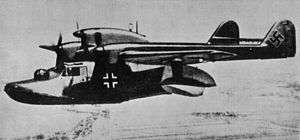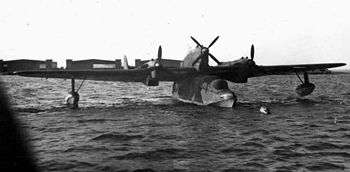Blohm & Voss BV 138
| BV 138B | |
|---|---|
 | |
| An image of a BV 138 published in a British Aircraft guide. | |
| Role | Maritime patrol Long-Range Reconnaissance |
| Manufacturer | Blohm & Voss |
| Designer | Richard Vogt |
| First flight | 15 July, 1937 |
| Introduction | October, 1940 |
| Primary user | Luftwaffe |
| Produced | 1938–1943 |
| Number built | 297 |
|
| |
The Blohm & Voss BV 138 Seedrache (Sea Dragon), but nicknamed Der Fliegende Holzschuh ("flying clog",[1] from the side-view shape of its fuselage) was a World War II German trimotor flying boat that served as the Luftwaffe's main seaborne long-range maritime patrol and naval reconnaissance aircraft.
A total of 297 BV 138s were built between 1938 and 1943.
Design and development

The appearance of the BV 138 was unique, in its combination of unusual design features, such as: twin boom tail unit, trimotor configuration, and fuselage slung beneath the wings. One nickname, "the Flying Clog" was derived from the shape of the slab-sided hull unit. These features together produced the aircraft's ungainly appearance, but inspired a certain affection among its crew and mechanics.
Three piston engines were used. The central engine was mounted above the wing, driving a four-blade propeller, while the wing engines were lower, with three-blade propellers. The pre-production prototypes and the BV 138 A-01 to BV 138 A-06, were powered by various makes of engines ranging from 485–746 kW (650–1,000 hp). The first standardized version, BV 138 B-1, was powered by three 880 PS (868 hp, 647 kW) Junkers Jumo 205D two-stroke, opposed-piston aircraft diesel engines. The engine cowlings also had an atypical appearance, due to the unique nature of the vertical orientation of the six-cylinder opposed-piston Jumo 205 diesel engines, and resembled the cowlings of 4 or 6-cylinder inverted inline engines found on smaller civil and utility aircraft from the Jumo 205's propshaft placement, emerging forward at the uppermost front end of the powerplant.
The booms of the twin tail unit, much like the smaller Focke-Wulf Fw 189 twin-engined reconnaissance monoplane, extended horizontally from the rear of the outer engine nacelles.
For hydrodynamic reasons, the hull featured a distinct "turn-down", or "beak" at the stern.
Two enclosed, powered gun turrets, each mounting a single MG 151/20 autocannon, were located prominently at the bow and stern. A third, fully open Scarff ring-like emplacement, behind the central engine and forward of the rear turret, mounted a 13 mm MG 131 heavy machine gun covered fields of fire obstructed from the other turrets by the horizontal stabilizer.
Operational history
In all, 227 examples of standard service variants of the BV 138 were built. The first such variant, BV 138 C-1, began service in March 1941. While non-standard variants carried a variety of armament, the standard variant featured two 20 mm MG 151/20 cannons, one in a power-operated bow turret and one in a power-operated stern turret, up to three 7.92 mm MG 15 machine guns, and a 13 mm (.51 in) MG 131 machine gun in the aft center engine nacelle. It could carry up to 500 kg (1,100 lb) of bombs or depth charges (under the starboard wing root only) or, in place of these, up to 10 passengers.
Both the B-1/U1 and C-1/U1 variants had racks under both wings to double the offensive load.[2]
Some examples of the BV 138 were adapted to specialized roles. The Bv 138 was tested with the oft-used Walter HWK 109-500 Starthilfe RATO jettisonable rocket pod, used in pairs, for shorter takeoff performance.[3] One anti-shipping variant carried FuG 200 Hohentwiel low-UHF band maritime search radar. The BV 138 MS variant was converted for minesweeping,[4] and carried magnetic field-generating degaussing equipment, including a hoop antenna with a diameter equal to the length of the fuselage, which encircled the hull and wings, which was also used on certain models of the Ju 52/3m trimotor transport used for the same duty.
Variants

- Prototypes
- developed under Hamburger Flugzeugbau designation
- Ha 138 V1 (D-ARAK) – First flight on 15 July 1937
- Ha 138 V2 (D-AMOR) – First flight in August 1937
- Ha 138 V3 – Construction abandoned due to redesign.
- Production
- BV 138 A-01 to 06 – Operational testbeds
- BV 138 A-1 – Flew reconnaissance during invasion of Norway
- BV 138 B-0 – Officially entered service in October 1940
- BV 138 B-1 – Entered service in November 1940
- BV 138 B-1/U1
- BV 138 C-1, also had minesweeper variant
- BV 138 C-1/U
- BV 138 MS – Minesweeping version.
Surviving aircraft

No complete BV 138s remain in existence. However, the wreck of one aircraft, sunk after the war in a British air show, was raised from the seabed of the Øresund Sound in 2000, and is on display at the Danish Technical Museum in Helsingør.
On 27 June 2012, two divers (Pascale Roibu and Iulian Rusu) found a Heinkel He 114 seaplane in Siutghiol Lake near Mamaia, Constanta, Romania. During that time, the two divers also found pieces of a Blohm & Voss BV 138 seaplane.
In June 2013, a vessel from the Norwegian Geological Survey filmed a Blohm & Voss BV 138 at a depth of 35 m in Porsangerfjorden, Norway, not far from the WW2 German seaplane harbour in Indre Billefjord.[5]
Specifications (BV 138 C-1)

Data from Wagner, Ray and Nowarra, Heinz. German Combat Planes: A Comprehensive Survey and History of the Development of German Military Aircraft from 1914 to 1945. New York: Doubleday, 1971, pg. 358
General characteristics
- Crew: 6, pilot, navigator, radio operator, nose gunner, rear gunner, upper rear gunner + up to 10 passengers
- Length: 19.85 m (65 ft 1½ in)
- Wingspan: 26.94 m (88 ft 4½ in)
- Height: 5.90 m (19 ft 4 in)
- Wing area: 112 m² (1,205.5 ft²)
- Empty weight: 11,770 kg (25,950 lb)
- Loaded weight: 14,500 kg (31,970 lb)
- Max. takeoff weight: 17,500 kg (38,590 lb)
- Powerplant: 3 × Junkers Jumo 205D opposed piston diesel engine with 12 pistons in 6 cylinders, 647 kW (868 hp) 880 PS each
Performance
- Maximum speed: 285 km/h @ 6,000 m (177 mph @ 19,700 ft)
- Cruise speed: 200 km/h (124 mph)
- Range: 4,300 km (2,670 mi)
- Service ceiling: 5,000 m (16,400 ft)
- Rate of climb: 220 m/min (729 ft/min)
- Wing loading: 114.2 kg/m² (23.4 lb/ft²)
- Power/mass: 0.106 kW/kg (0.064 hp/lb)
Armament
- 2 × 20 mm MG 151 cannon, one in a nose turret and one in the rear fuselage covering upper rear area
- 1 × 13 mm (.51 in) MG 131 machine gun in open position behind the central engine, covering the top rear area
- 1-3 × 7.92 mm MG 15 machine guns (optional)
- up to 6 x 50kg bombs or 4 x 150kg depth charges under starboard wing root only (optional)
See also
- Related lists
References
Notes
- ↑ Nowarra 1997, original German title of the Schiffer book.
- ↑ BV 138 Specifications
- ↑ Video of HWK 109-500 Starthilfe-boosted Blohm & Voss Bv 138 flying boat takeoff
- ↑ The "MS" suffix of the BV 138 MS signified Minensuch (literally "mine search")
- ↑ NRK Nordnytt 14 June 2013
Bibliography
- Green, William. Warplanes of the Second World War, Volume Five: Flying Boats. London: Macdonald & Co.(Publishers) Ltd., 5th impression 1972. ISBN 0-356-01449-5.
- Green, William. Warplanes of the Third Reich. London: Macdonald and Jane's Publishers Ltd., 4th impression 1979. ISBN 0-356-02382-6.
- Ledwoch, Janusz. Bv 138 (Wydawnictwo Militaria 64) (in Polish). Warszaw, Poland: Wydawnictwo Militaria, 1998. ISBN 83-7219-015-1.
- Nowarra, Heinz J. and Don Cox, (transl.) Blohm & Voss Bv 138 (Schiffer Military History). Atglen, Pennsylvania: Schiffer Publishing Ltd., 1997. ISBN 0-7643-0296-5.
- Smith J. Richard and Anthony Kay. German Aircraft of the Second World War. London: Putnam & Company Ltd., 1972 (3rd impression 1978). ISBN 0-370-00024-2.
- Wagner, Ray and Nowarra, Heinz. German Combat Planes: A Comprehensive Survey and History of the Development of German Military Aircraft from 1914 to 1945. New York: Doubleday, 1971.
External links
| Wikimedia Commons has media related to Blohm & Voss BV 138. |
- Article on a BV 138 which sank near Trondheim in Norway
- Website dedicated to the BV 138
- Specs
- German plane wrecks in Norway, WWII